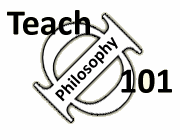Teach Philosophy 101
Free resources for
philosophy teachers!
"One of the most comprehensive, well-researched, and accessible guides for teachers that I have ever seen." James Lang, Chronicle of Higher Education (read full review of TΦ101)
Structuring Your Lecture
Terry O'Connor at the College of New Jersey suggests structuring a lecture to flow through five different "social learning activities." He also suggests a basic lecture pattern.
Social Learning Activities:
-
Entrance -- set tone and establish trust, established by greeting students, exchanging information.
-
Settle down -- shifting individuals from focus on individual and personal to group tasks, established by setting agenda for the day, dramatically grabbing attention, distributing a handout, posing a problem or thought for the day's class.
-
Work -- working through the main substance of the material. O'Connor suggests a basic pattern, that might be repeated several times through the main body of the lecture:
-
Present concept
-
Provide example
-
Get student example (an active participation that resets attention)
-
Closure.
-
-
Resetting attention -- all of the studies suggest that students' attention fades after a surprisingly short amount of lecture time. The best practice is to change up the pace shifting from lecturing to some other activity. One faculty member says this: "I have just set my computer to ring an alarm in ten minutes. When the alarm goes off I'll ask you to write down the most important thing you heard in that ten minutes."
-
Clear Up -- a time for individuals to reflect on what has happened, could include some sort of summary exercise like the one minute paper, or a summary by the instructor, or a connection to previous work. Some faculty members ask students to write down the "muddiest point" (least clear thing from the lecture).
-
Exit -- clarify activities for the future, return material, make announcements, remind students of next assignment (they have it on the syllabus but it is better to remind them in person), explain what will be learned in next assignment.
Monitoring your performance:
When it comes to lectures, we have an excellent way of checking how effective we are. Kevin Johnson, director of the Michigan State University Teaching Assistant Program (TAP), suggests that you periodically collect five student notebooks and study them to see what your students are actually writing. He gives a list of things to look for as symptoms of problems (such as no paragraph structure, no summarizing comments, no questions or question marks. These comments are in Thought #15, in the 2009-2010 MSU Teaching Thoughts.
Source:
O'Connor, Terry (The College of New Jersey), "The Complete Lecture," presentation at the Lilly East Conference: Learning by Design, University of Delaware, April 2008.
Author: John Immerwahr
Update: July 5, 2012
